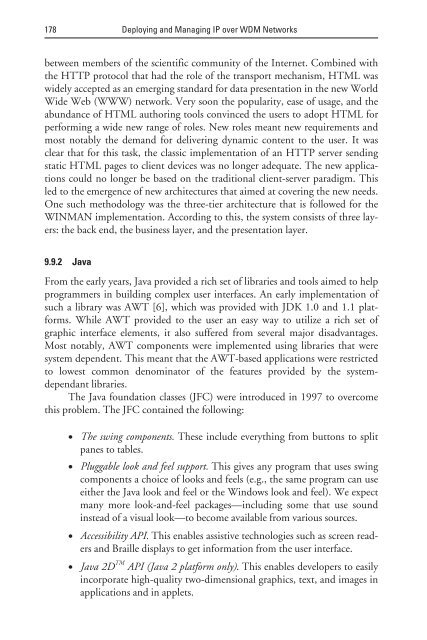deploying and managing ip over wdm networks - Index of
deploying and managing ip over wdm networks - Index of
deploying and managing ip over wdm networks - Index of
You also want an ePaper? Increase the reach of your titles
YUMPU automatically turns print PDFs into web optimized ePapers that Google loves.
178 Deploying <strong>and</strong> Managing IP <strong>over</strong> WDM Networks<br />
between members <strong>of</strong> the scientific community <strong>of</strong> the Internet. Combined with<br />
the HTTP protocol that had the role <strong>of</strong> the transport mechanism, HTML was<br />
widely accepted as an emerging st<strong>and</strong>ard for data presentation in the new World<br />
Wide Web (WWW) network. Very soon the popularity, ease <strong>of</strong> usage, <strong>and</strong> the<br />
abundance <strong>of</strong> HTML authoring tools convinced the users to adopt HTML for<br />
performing a wide new range <strong>of</strong> roles. New roles meant new requirements <strong>and</strong><br />
most notably the dem<strong>and</strong> for delivering dynamic content to the user. It was<br />
clear that for this task, the classic implementation <strong>of</strong> an HTTP server sending<br />
static HTML pages to client devices was no longer adequate. The new applications<br />
could no longer be based on the traditional client-server paradigm. This<br />
led to the emergence <strong>of</strong> new architectures that aimed at c<strong>over</strong>ing the new needs.<br />
One such methodology was the three-tier architecture that is followed for the<br />
WINMAN implementation. According to this, the system consists <strong>of</strong> three layers:<br />
the back end, the business layer, <strong>and</strong> the presentation layer.<br />
9.9.2 Java<br />
From the early years, Java provided a rich set <strong>of</strong> libraries <strong>and</strong> tools aimed to help<br />
programmers in building complex user interfaces. An early implementation <strong>of</strong><br />
such a library was AWT [6], which was provided with JDK 1.0 <strong>and</strong> 1.1 platforms.<br />
While AWT provided to the user an easy way to utilize a rich set <strong>of</strong><br />
graphic interface elements, it also suffered from several major disadvantages.<br />
Most notably, AWT components were implemented using libraries that were<br />
system dependent. This meant that the AWT-based applications were restricted<br />
to lowest common denominator <strong>of</strong> the features provided by the systemdependant<br />
libraries.<br />
The Java foundation classes (JFC) were introduced in 1997 to <strong>over</strong>come<br />
this problem. The JFC contained the following:<br />
• The swing components. These include everything from buttons to split<br />
panes to tables.<br />
• Pluggable look <strong>and</strong> feel support. This gives any program that uses swing<br />
components a choice <strong>of</strong> looks <strong>and</strong> feels (e.g., the same program can use<br />
either the Java look <strong>and</strong> feel or the Windows look <strong>and</strong> feel). We expect<br />
many more look-<strong>and</strong>-feel packages—including some that use sound<br />
instead <strong>of</strong> a visual look—to become available from various sources.<br />
• Accessibility API. This enables assistive technologies such as screen readers<br />
<strong>and</strong> Braille displays to get information from the user interface.<br />
• Java 2D TM API (Java 2 platform only). This enables developers to easily<br />
incorporate high-quality two-dimensional graphics, text, <strong>and</strong> images in<br />
applications <strong>and</strong> in applets.


